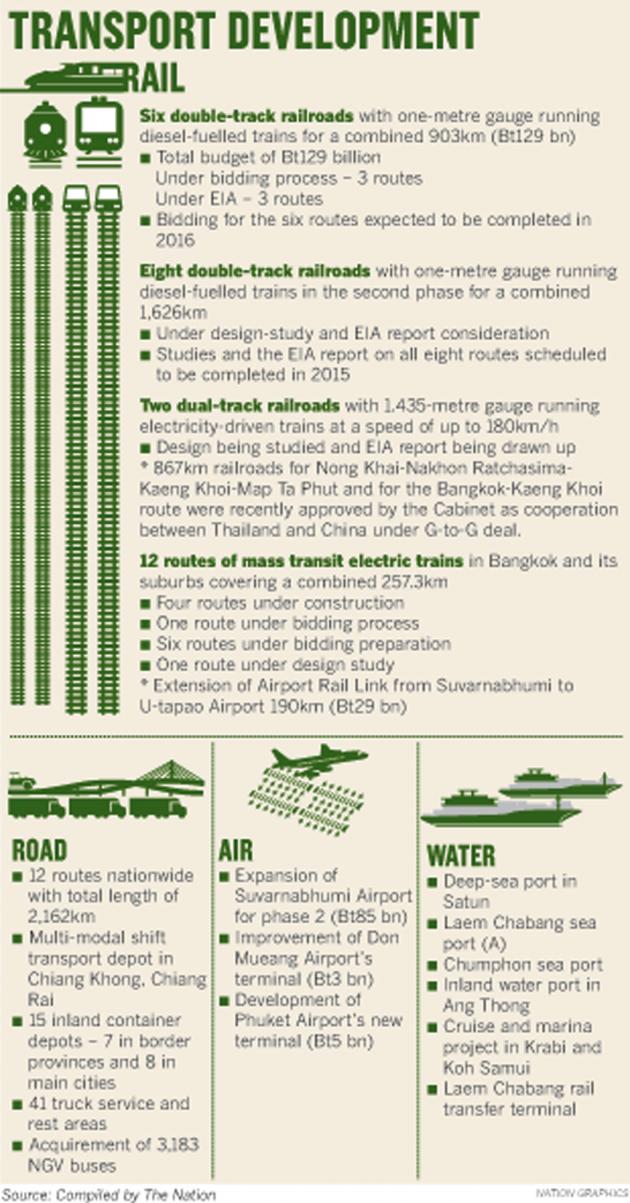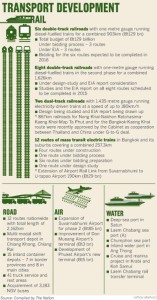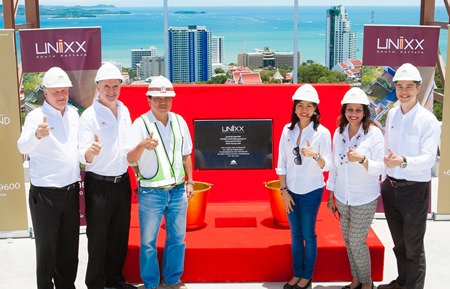The upcoming transport-system mega-projects will reshape the Kingdom’s urbanisation, with major cities a factor in the country’s economic growth.
After seizing power in May from the elected government that had set out a far-reaching plan for upgrading the country’s transport networks, the military regime announced a similar eight-year (2015-2022) transport investment plan worth as much as Bt3 trillion.
Railways have been highlighted as the backbone of the infrastructure project, accounting for more than half of the total budget. Other modes such as roads and inland water transport will be feeders for the rail network, while, air transport can be an alternative.
Eight double-track rail routes are planned. If things go according to plan, the first of these should be seen in 2019. By 2022, the total length of the nationwide 1-metre-gauge rail network should be doubled to 8,000 kilometres. Rail will account for 5 per cent of total transport in 2022, up from 2.5 per cent currently, Transport Minister Air Chief Marshal Prajin Juntong has said.
Meanwhile in Greater Bangkok, the mass-transit train network will cover roughly 260km, compared with 90km currently.
In the new year, some of the planned projects will be put out for tender, while others will enter the study stage.
The country will use two rail gauges. Routes using the 1.435-metre “standard” gauge will connect with other Asean countries plus China, while Thailand’s existing 1-metre-gauge trains will continue to be used for intercity transport within the Kingdom.
China is to cooperate with Thailand on the construction of two standard-gauge double-track routes worth Bt400 billion, a preliminary agreement on which was signed early this month. The two projects will be the 737km Nong Khai-Korat-Kaeng Khoi-Laem Chang-Map Ta Phut route and the 133km Kaeng Khoi-Bangkok route. The electric trains will be capable of speeds of 180km/h and used primarily for cargo. The construction period will be 2016 to 2021.
Japan has also expressed interest in cooperating with Thailand on three other routes. The first of these will run from Tak to Mukdahan, the second from Punamron in Kanchanaburi to Rayong via Bangkok, and the third from Bangkok to Chiang Khong, Chiang Rai province, via Chiang Mai. Talks between the two governments are to begin soon.
Booming properties
The expansion of the transport network will not only make travel more convenient and save logistics costs, it will stimulate urbanisation and wealth distribution. New business hubs will create more jobs, and affordable housing will be offered.
Land prices in many parts of such provinces as Khon Kaen, Udon Thani and Chon Buri, as well as Hua Hin in Prachuap Khiri Khan province, have ballooned by at least 30 per cent in the past few years on speculation surrounding the new transport network. Residential projects and shopping and building complexes have been mushrooming in those areas.
Khon Kaen is expected to become a new transport hub in the Northeast. The province along with the private sector is planning to raise billions of baht to construct a mass-transit light rail system powered by electricity as a feeder to the intercity railway network to reduce urban congestion.
Meanwhile, many residential projects are popping up in suburban areas in a 20km radius of central Bangkok along the planned electric train lines. Taling Chan will become a sub-centre in the west, Lum Luk Ka (Rangsit) in the north, Lat Krabang in the east, and Bang Khun Thian in the south.
Connected with a light-rail Bang Na-Suvarnabhumi route linked to the Skytrain, Bang Na will become a new commercial centre in the east of Bangkok.
Many more condominium projects in the Bang Na area will be launched, while the Bt20-billion Bangkok Mall shopping complex will be developed on 100 rai (16 hectares). Some existing condo projects could jack up their prices by more than 10 per cent, while land prices within 500 metres of the complex are expected to rise by 30-50 per cent.
Other areas along Ratchaphruek Road, 20km west of Bangkok, which will be served by the Green and Purple lines, have seen new launches of residential properties, community malls, markets and modern shops.
“Urban sprawl with an appropriate expansion of infrastructure development on a transit-oriented development basis will result in effective city expansion and usage of space with value for money,” Panit Pujinda, assistant professor at Chulalongkorn University’s architecture faculty, suggested to the government previously.
Source: http://www.nationmultimedia.com/business/Transport-mega-projects-set-to-stimulate-urbanisat-30250678.html



